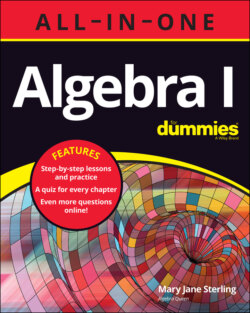Читать книгу Algebra I All-in-One For Dummies - Mary Jane Sterling, Mary Sterling Jane - Страница 32
Practice Questions Answers and Explanations
Оглавление1 The numbers 15, 11, and are natural numbers. The number qualifies, because it simplifies to the number 3.
2 The numbers –41, 15, 11, , and are integers. The fraction simplifies to , and is equal to 3.
3 The numbers are all rational numbers.
They can all be written as a fraction with integers in the numerator and denominator.
4 The number is the only irrational number listed here. Technically, can be written as , but the i makes the number imaginary. And the can be simplified to create a rational number.
5 The numbers 11 and 3 are prime. Yes, appears again!
6 The only imaginary number is or .
7
The points 0.5 and 3.2 are approximated, because the tick marks aren’t on the number line.
8
9 3. There are three terms. The term 4x is separated from 3x3 by subtraction and from 11 by addition.
10 5. There are two terms, and each has a different number of factors. The first term, 3xy, has three factors: the 3 and the x and the y are multiplied together. The second term, 2z, has two factors, the 2 and the z. So there are a total of five factors.
11 x and y; h, k, a, b, 1. The two variables are x and y. The constants are h, k, a, b, and 1.
12 2, , and 1. The exponent in the term z2 is the 2; the z is the base. The exponent in z1/2 is . And, even though it isn’t showing, there’s an implied exponent in the term z; it’s assumed to be a 1, and the term can be written as z1.
13 . You could put the dot between the 4 and the z to indicate multiplication, but writing them together assumes they’re being multiplied.
14 . Use a fraction to indicate multiplication, rather than the slash.
15 . Writing the 6 next to the absolute value indicates multiplication. The subtraction is written completely under the radical.
16 .
17 or .
18 The braces contain two terms: the 16 and the fraction. The 5 in front of the braces indicates that multiplication will be performed. The fraction line has the term in the numerator and the number 12 in the denominator. And the parentheses have a multiplier of 4 in front and the two terms 11 and z inside, which need to be subtracted.
19 . The 9 can be written behind or in front of the parentheses.
20 . The x goes in the denominator.
21 . Use parentheses if the –2 follows the x.
22 . Use the greater-than-or-equal-to symbol.
23 . You subtract the 8 from the 9, and you add the 2x and 7x to get 9x. (It’s like adding 2 apples to 7 apples!)
24 . Both 14y and are divisible by 14. So you write the 14 outside the parentheses and put the division results inside the parentheses.
25 . The only number you can add to 8 to get a result of 10 is 2.
26 Yes, they are both solutions. and
If you’re ready to test your skills a bit more, take the following chapter quiz that incorporates all the chapter topics.
